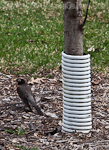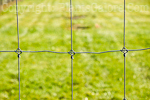1. Fencing
-
Small Animals - Since these animals are not very
tall, the height of the fencing does not need to be
great. Temporary fencing such as chicken wire may be
used to protect shorter plants during the winter
months. Hardware cloth with 1/4 inch squares should
be used if you are dealing with
Chipmunks,
Mice,
Squirrels or
Voles.
-
Deer - Fencing
for deer may work but it is more difficult to use in
urban or suburban gardens. More on
Deer Fencing...
-
Digging
Animals - For animals such as
Chipmunks,
Groundmoles,
Mice,
Squirrels,
Voles,
and
Woodchucks that
burrow beneath decks, porches, paths, etc. you may
need to use a technique which involves burying the
fencing material.
This involves taking a 36 inch high segment of
either chicken wire or hardware cloth and folding
the bottom 12 inches at a 90 degree angle. Then dig
down 12 inches deep in the soil and 12 inches wide
next to the path or structure. Place the 12 inch
length of fencing the the hole and bury it.
Most of the digging critters will go up close to the
structure, path, etc. and then dig down before going
under. By burying the wire in the fashion described
above, the animal will run into the fencing and be
discouraged from going any further.
 2. Tree Wraps -
Rodents including
Chipmunks,
Mice,
Squirrels,
Voles and
Woodchucks may chew
on the bark of young trees during the winter. To help
prevent this, various types of tree wraps are available.
Plastic wraps are probably the most effective. Remember
to avoid leaving these wraps on too many seasons since
they may eventually grow into the bark and kill the
tree. They only need to be on until the bark gets rough
looking and "mature". 2. Tree Wraps -
Rodents including
Chipmunks,
Mice,
Squirrels,
Voles and
Woodchucks may chew
on the bark of young trees during the winter. To help
prevent this, various types of tree wraps are available.
Plastic wraps are probably the most effective. Remember
to avoid leaving these wraps on too many seasons since
they may eventually grow into the bark and kill the
tree. They only need to be on until the bark gets rough
looking and "mature".
|




 Of course one of the best
ways to eliminate a problem is to exclude it in the
first place. There are many ways to keep potentially
damaging animals away from your landscape. The challenge
is to do so in an aesthetically pleasing way.
Of course one of the best
ways to eliminate a problem is to exclude it in the
first place. There are many ways to keep potentially
damaging animals away from your landscape. The challenge
is to do so in an aesthetically pleasing way.  2. Tree Wraps -
Rodents including
2. Tree Wraps -
Rodents including

